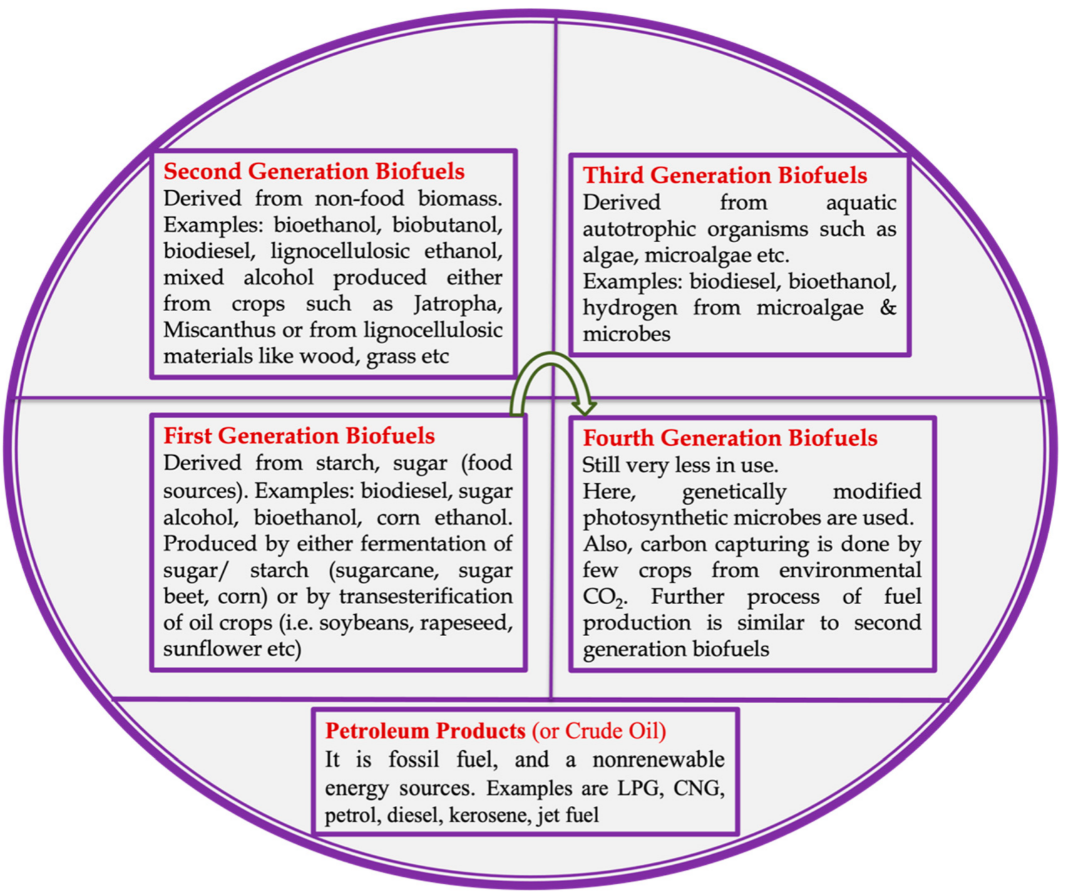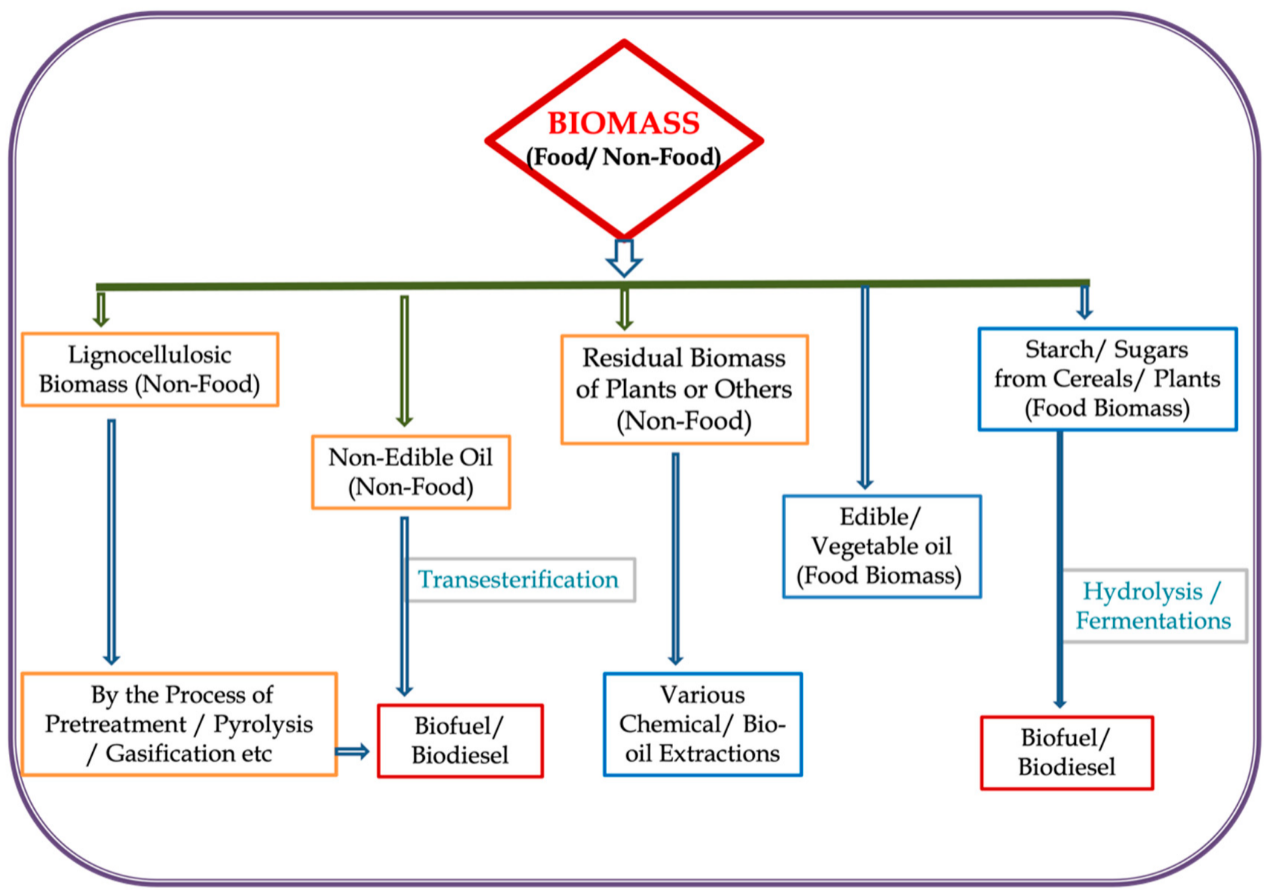
| Version | Summary | Created by | Modification | Content Size | Created at | Operation |
|---|---|---|---|---|---|---|
| 1 | Ashutosh Kumar Rai | -- | 4036 | 2022-04-21 11:03:35 | | | |
| 2 | Vivi Li | -2760 word(s) | 1276 | 2022-04-22 06:06:14 | | |
Video Upload Options
Biofuel consists of non-fossil fuel derived from the organic biomass of renewable resources, including plants, animals, microorganisms, and waste. Energy derived from biofuel is known as bioenergy. The reserve of fossil fuels is now limited and continuing to decrease, while at the same time demand for energy is increasing. In order to overcome this scarcity, it is vital for human beings to transfer their dependency on fossil fuels to alternative types of fuel, including biofuels, which are effective methods of fulfilling present and future demands. The conversion of lignocellulosic feedstock is an important step during biofuel production. It is, however, important to note that, as a result of various technical restrictions, biofuel production is not presently cost efficient, thus leading to the need for improvement in the methods employed.
1. Introduction

- (i)
-
First-generation biofuel is primarily derived from parts of edible plants (i.e., grains and oilseeds). These types of fuel have derived from sugar, starch, vegetable oil, and fats. Examples of most popular first-generation biofuels are biodiesel, ethanol, biofuel gasoline, biogas, etc. [7][13][24][26]. Presently, first-generation biofuel (biodiesel and bioethanol) is mainly produced by using agricultural feedstock such as sugarcane, corn, sugar beets, etc. [23]. Economic feasibility of biofuel production using crops (such as oilseed crops) as feedstock is not cost effective presently, therefore, a more efficient approach is needed to enhance the biofuel production and convert it to an economically feasible stage. Additionally, more research work is needed to increase the biodiesel production using first-generation feedstock such as oil [23].
- (ii)
-
Second-generation biofuel is a comparatively advanced biofuel which is derived from various non-food biomass of plant/or animal. Second-generation (lignocellulosic) biofuel is derived from non-edible plants or non-edible parts of the plants. It is well known that non-edible lignocellulosic biomass (such as vegetable grasses, forest residues, agricultural waste, etc.) is present abundantly in the natural ecosystem, therefore, it could be used as a feedstock for biofuel production. Examples of second-generation biofuels are lignocellulosic ethanol, butanol, mixed alcohols, etc. [4][13][24][27].
- (iii)
-
Third-generation biofuel is derived from photosynthetic microbes, e.g., microalgae. They derived from autotrophic organism. Here, carbon dioxide, light, and other nutrient sources are used in the synthesis of feedstock (biomass) which is further used in biofuel production [8][24][25][28]. Biofuels obtained from third-generation sources (such as microalgae) might be a better energy substitute as compared to previous generation biofuels, due to their short life cycle and less requirement of valuable agricultural land and resources for their growth [25]. Algae have rapid growth and higher rate of the photosynthesis compared to terrestrial plants used in first- and second-generation biofuel production. Due to their use in biofuel production, photosynthetic microbes (such as algae/microalgae) have recently received more attention from researchers worldwide [12].
- (iv)
-
Fourth-generation biofuel is not common and at an under developmental stage since a few years ago. Here, genetically altered photosynthetic microbes (such as cyanobacteria, algae, fungi) are used as feedstock. Photosynthetic microbes have the ability to convert atmospheric CO2 to biofuel [24]. Some studies reported that carbon capturing is undertaken by some crops, taken from the atmosphere and further stored in their leaves, stems, etc., which is further converted into fuel using second-generation techniques [12]. Alalwan et al. [24] reported that, in the fourth-generation biofuels, genetically modified microorganisms are used to obtain more carbon (HC) yield and reduced carbon emissions [24].
2. Second-Generation Lignocellulosic Biofuels

3. Feedstock for Second-Generation Lignocellulosic Biofuels
References
- Liu, Y.; Cruz-Morales, P.; Zargar, A.; Belcher, M.S.; Pang, B.; Englund, E.; Dan, Q.; Yin, K.; Keasling, J.D. Biofuels for a sustainable future. Cell 2021, 184, 1636–1647.
- Afolalu, S.A.; Yusuf, O.O.; Abioye, A.A.; Emetere, M.E.; Ongbali, S.O.; Samuel, O.D. Biofuel, a sustainable renewable source of energy—A review. IOP Conf. Ser. 2021, 665, 012040.
- Khan, M.A.H.; Bonifacio, S.; Clowes, J.; Foulds, A.; Holland, R.; Matthews, J.C.; Percival, C.J.; Shallcross, D.E. Investigation of Biofuel as a Potential Renewable Energy Source. Atmosphere 2021, 12, 1289.
- Perea-Moreno, M.A.; Samerón-Manzano, E.; Perea-Moreno, A.J. Biomass as renewable energy: Worldwide research trends. Sustainability 2019, 11, 863.
- Guo, M.; Song, W.; Buhain, J. Bioenergy and biofuels: History, status and prespective. Renew. Sustain. Energy Rev. 2015, 42, 712–725.
- Nazari, M.T.; Mazutti, J.; Basso, L.G.; Colla, L.M.; Brandli, L. Biofuels and their connections with the sustainable development goals: A bibliometric and systematic review. Environ. Dev. Sustain. 2021, 23, 11139–11156.
- Aro, E.-M. From first generation biofuels to advanced solar biofuels. Ambio 2016, 45, 24–31.
- Kumar, V.; Nanda, M.; Joshi, H.C.; Singh, A.; Sharma, S.; Verma, M. Production of biodiesel and bioethanol using algal biomass harvested from fresh water river. Renew. Energy 2018, 116, 606–612.
- Muhammad, U.L.; Shamsuddin, I.M.; Danjuma, A.; Musawa, R.S.; Dembo, U.H. Biofuels as the starring substitute to fossil fuels. Pet. Sci. Eng. 2018, 2, 44–49.
- Subramaniam, Y.; Masron, T.A.; Azman, N.H.N. Biofuels, environmental sustainability and food security: A review of 51 countries. Energy Res. Soc. Sci. 2020, 68, 101549.
- Ganguly, P.; Sarkhel, R.; Das, P. The second-and third-generation biofuel technologies: Comparative perspectives. In Sustainable Fuel Technologies Handbook; Academic Press: Cambridge, MA, USA, 2021; pp. 29–50.
- Dutta, K.; Daverey, A.; Lin, J.-G. Evolution retrospective for alternative fuels: First to fourth generation. Renew. Energy 2014, 69, 114–122.
- Naik, S.N.; Goud, V.V.; Rout, P.K.; Dalai, A.K. Production of first and second generation biofuels: A comprehensive review. Renew. Sustain. Energy Rev. 2010, 14, 578–597.
- Pandit, S.; Savla, N.; Sonawane, J.M.; Sani, A.M.; Gupta, P.K.; Mathuriya, A.S.; Rai, A.K.; Jadhav, D.A.; Jung, S.P.; Prasad, R. Agricultural waste and wastewater as feedstock for bioelectricity generation using microbial fuel cells: Recent advances. Fermentation 2021, 7, 169.
- Shahid, M.K.; Batool, A.; Kashif, A.; Nawaz, M.H.; Aslam, M.; Iqbal, N.; Choi, Y. Biofuels and biorefineries: Development, application and future perspectives emphasizing the environmental and economic aspects. J. Environ. Manag. 2021, 297, 113268.
- Sindhu, R.; Binod, P.; Pandey, A.; Ankaram, S.; Duan, Y.; Awasthi, M.K. Biofuel production from biomass: Toward sustainable development. In Current Developments in Biotechnology and Bioengineering; Kumar, S., Kumar, R., Pandey, A., Eds.; Elsevier: Amsterdam, The Netherlands, 2019; pp. 79–92.
- Al Makishah, N.H.; Rai, A.K.; Neamatallah, A.A.; Mabrouk, A.M. Micrococcus luteus 2030: A novel lipolytic bacterial strain isolated from local contaminated soil in Saudi Arabia. Sylwan 2019, 163, 132–152.
- Sánchez, Ó.J.; Cardona, C.A. Trends in biotechnological production of fuel ethanol from different feedstocks. Bioresour. Technol. 2008, 99, 5270–5295.
- Escobar, J.C.; Lora, E.S.; Venturini, O.J.; Yánez, E.E.; Castillo, E.F.; Almazan, O. Biofuels: Environment, technology and food security. Renew. Sustain. Energy Rev. 2009, 13, 1275–1287.
- Jusakulvijit, P.; Bezama, A.; Thrän, D. The availability and assessment of potential agricultural residues for the regional development of second-generation bioethanol in Thailand. Waste Biomass Valor. 2021, 12, 6091–6118.
- EASAC. The Current Status of Biofuels in the European Union, Their Environmental Impacts and Future Prospects; German National Academy of Sciences Leopoldina: Haale, Germany, 2012; 47p, ISBN 978-3-8047-3118-9.
- Oumer, A.N.; Hasan, M.M.; Baheta, A.T.; Mamat, R.; Abdullah, A.A. Bio-based liquid fuels as a source of renewable energy: A review. Renew. Sust. Energ. Rev. 2018, 88, 82–98.
- Hirani, A.H.; Javed, N.; Asif, M.; Basu, S.K.; Kumar, A. A review on first-and second-generation biofuel productions. In Biofuels: Greenhouse Gas Mitigation and Global Warming; Kumar, A., Ogita, S., Yau, Y.Y., Eds.; Springer: New Delhi, India, 2018; pp. 141–154.
- Alalwan, H.A.; Alminshid, A.H.; Aljaafari, H.A. Promising evolution of biofuel generations. Subject review. Renew. Energy Focus. 2019, 28, 127–139.
- Dragone, G.; Fernandes, B.; Vicente, A.A.; Teixeira, J.A. Third generation biofuels from microalgae. In Current Research, Technology and Education Topics in Applied Microbiology and Microbial Biotechnology; Mendez-Vilas, A., Ed.; FORMATEX: Badajoz, Spain, 2010; pp. 1355–1366.
- Gumienna, M.; Szambelan, K.; Jelen, H.; Czarnecki, Z. Evaluation of ethanol fermentation parameters for bioethanol production from sugar beet pulp and juice. J. Inst. Brew. 2014, 120, 543–549.
- Sims, R.E.H.; Mabee, W.; Saddler, J.N.; Taylor, M. An overview of second generation biofuel technologies. Bioresour. Technol. 2010, 101, 1570–1580.
- Hussain, F.; Shah, S.Z.; Ahmad, H.; Abubshait, S.A.; Abubshait, H.A.; Laref, A.; Manikandan, A.; Kusuma, H.S.; Iqbal, M. Microalgae an ecofriendly and sustainable wastewater treatment option: Biomass application in biofuel and bio-fertilizer production. A review. Renew. Sust. Energ. Rev. 2021, 137, 110603.
- Schenk, P.M.; Thomas-Hall, S.R.; Stephens, E.; Marx, U.C.; Mussgnug, J.H.; Posten, C.; Kruse, O.; Hankamer, B. Second Generation Biofuels: High-Efficiency Microalgae for Biodiesel Production. Bioenerg. Res. 2008, 1, 20–43.
- Eisentraut, A. Sustainable Production of Second-Generation Biofuels: Potential and Perspectives in Major Economies and Developing Countries; IEA Energy Papers, No. 2010/01; OECD Publishing: Paris, France, 2010; 221p.
- Scully, S.M.; Orlygsson, J. Recent advances in second generation ethanol production by thermophilic bacteria. Energies 2015, 8, 1–30.
- Gomez, L.D.; Clare, G.S.; McQueen-Mason, J. Sustainable liquid biofuels from biomass: The writing’s on the walls. New Phytol. 2008, 178, 473–485.
- Zabaniotou, A.; Ioannidou, O.; Skoulou, V. Rapeseed residues utilization for energy and 2nd generation biofuels. Fuel 2008, 87, 1492–1502.
- Dhiman, S.; Mukherjee, G. Present scenario and future scope of food waste to biofuel production. J. Food Process Eng. 2021, 44, e13594.
- Mizik, T.; Gyarmati, G. Economic and sustainability of biodiesel production- A systematic literature review. Clean Technol. 2021, 3, 19–36.
- Arefin, M.A.; Rashid, F.; Islam, A. A review of biofuel production from floating aquatic plants: An emerging source of bio-renewable energy. Biofuel. Bioprod. Biorefin. 2021, 15, 574–591.
- Badawy, T.; Mansour, M.S.; Daabo, A.M.; Aziz, M.M.A.; Othman, A.A.; Barsoum, F.; Basouni, M.; Hussien, M.; Ghareeb, M.; Hamza, M.; et al. Selection of second-generation crop for biodiesel extraction and testing its impact with nano additives on diesel engine performance and emissions. Energy 2021, 237, 121605.
- Pauly, M.; Keegstra, K. Cell-wall carbohydrates and their modification as a resource for biofuels. Plant J. 2008, 54, 559–568.
- Raud, M.; Kikas, T.; Sippula, O.; Shurpali, N.J. Potentials and challenges in lignocellulosic biofuel production technology. Renew. Sust. Energ. Rev. 2019, 111, 44–56.
- Aderibigbe, F.A.; Shiru, S.; Saka, H.B.; Amosa, M.K.; Mustapha, S.I.; Alhassan, M.I.; Adejumo, A.L.; Abdulraheem, M.; Owolabi, R.U. Heterogeneous catalysis of second generation oil for biodiesel production: A review. ChemBioEng Rev. 2021, 8, 78–89.
- Firouzi, S.; Allahyari, M.S.; Isazadeh, M.; Nikkhah, A.; van Haute, S. Hybrid multi-criteria decision-making approach to select appropriate biomass resources for biofuel production. Sci. Total Environ. 2021, 770, 144449.
- Narwane, V.S.; Yadav, V.S.; Raut, R.D.; Narkhede, B.E.; Gardas, B.B. Sustainable development challenges of the biofuel industry in India based on integrated MCDM approach. Renew. Energy 2021, 164, 298–309.
- Sarangi, P.K.; Nayak, M.M. Agro-Waste for Second-Generation Biofuels. In Liquid Biofuels: Fundamentals, Characterization, and Applications; Shadangi, K.P., Ed.; Scrivener Publishing LLC: Beverly, MA, USA, 2021; pp. 697–709.




